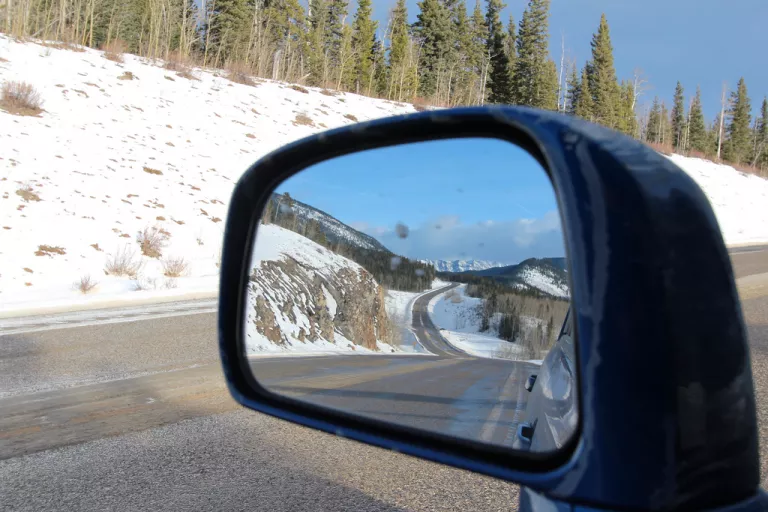Minimizing Our Transportation Impact: How to travel while lowering your footprint
By David Kassian
With the summer break on the horizon, many of us will find ourselves travelling long distances in order to see friends, family, the outdoors, or maybe a festival or two. When travelling near or far, it is important to reflect on how you may both reduce fuel consumption and lower emissions. There are several easy ways you can go explore while minimizing your impact on the environment.
While not all of us are mechanically inclined, there are a few simple things to keep in mind before driving distances near or far in a car. Before starting the engine, be sure to check your tire pressure. There are many easy guides online if you need help checking your tire pressure. Though at times tires may appear to be fully inflated, they can be deceiving and tires low air pressure may increase fuel consumption by as much as 6%. If you are not using the hard carrier on your roof rack, try leaving it behind as the increased air resistance can increase fuel consumption by as much as 20%. Likewise, avoid lugging unnecessary heavy goods while packing for your trip! Every 100 pounds in a car can decrease fuel efficiency by 1-2%.

Image source: https://www.flickr.com/photos/davebloggs007/11572250785/
There are many easy ways to minimize your fuel consumption while on the road. When weather permits, avoid excessive idling. Starting your engine will only take up a few seconds worth of fuel when compared to idling, but do so wisely, as turning your car on and off unnecessarily will increase wear on your starter.
While many of us will be excited to reach our destination, be sure not to speed too much! Vehicles operate most efficiently between 80km/h and 90km/h. Driving 120km/h can increase your fuel consumption by as much as 20% when compared to 90km/h. If it is too warm in your car during the summer months, attempt to drive with the windows up and the interior vents on. Driving with windows down or the air conditioner on may increase fuel consumption by 13% to 20%, depending on your vehicle.
Driving isn’t the only way to explore the countryside or travel to your favourite camping spot; there are many alternative methods of transportation you may employ. One popular method gaining traction is bike touring. Bike touring is not a competitive sport; rather, it is a leisure activity that many choose in order to lower their transportation impact while staying active and healthy. This method of transportation consists of a bicycle, typically a mountain or road bike, that is equipped with racks, panniers, and modern day saddlebags. Instead of loading your trunk with much needed camping supplies or festival necessities, bicycle tourists choose to pack everything they need onto their bicycle. For those new or interested in bicycle touring, there are many resources and guides online to help you build your bicycle.
Touring can range from one day to many, depending on the distance to your destination or how much time one would like to spend exploring. It is very important to have a well maintained bike alongside with spare common parts, as oftentimes one may find themselves with a flat tire in a remote location. Be sure to know how to swap out parts that are more susceptible to failure while on the road, such as tires, brake lines, and brake pads.
It is informative to explore the difference in environmental impacts between cycling and driving. Here we will focus on carbon emissions. A recent European study shows that the difference is staggering. The average vehicle, factoring in the production of the car and the emissions while driving it, emits roughly 271g of CO2 per passenger per kilometer. When compared to the bicycle, also factoring in production and the food required to power your pedals, your carbon footprint emits on average 21g of CO2 emissions per kilometer, less than one tenth that of diving a car!
Not only will travelling by bicycle lower your transportation footprint and contribute to a healthy lifestyle, it is also cost effective in the long run. Acquiring the necessary gear can be expensive in the short term, but there are many calculators online that allow you to compare the cost of travelling with a vehicle versus a bicycle. For example, if you were able to completely switch your transportation habits by cycling, walking, and using public transportation for one year, you could save as much as $9000. These calculators can be very specific, and a powerful tool when determining how to cut back on transportation costs.
Our whole transportation footprint isn’t based solely on the car we drive or how we operate it. Contemplate alternate methods of transportation such as bicycle touring before you put rubber to the pavement on your next adventure. Consider packing food and drinks rather than stopping at your favourite fast food joint. Bring along friends or try to carpool; many sites offer rideshare forums for those looking to travel with others. It is important for all of us to challenge ourselves on how we may minimize our impact on the environment. Whether the changes you make in your everyday life are big or small, be sure they contribute to a happier, healthier world.
About the Author

By David Kassian
With the summer break on the horizon, many of us will find ourselves travelling long distances in order to see friends, family, the outdoors, or maybe a festival or two. When travelling near or far, it is important to reflect on how you may both reduce fuel consumption and lower emissions. There are several easy ways you can go explore while minimizing your impact on the environment.
While not all of us are mechanically inclined, there are a few simple things to keep in mind before driving distances near or far in a car. Before starting the engine, be sure to check your tire pressure. There are many easy guides online if you need help checking your tire pressure. Though at times tires may appear to be fully inflated, they can be deceiving and tires low air pressure may increase fuel consumption by as much as 6%. If you are not using the hard carrier on your roof rack, try leaving it behind as the increased air resistance can increase fuel consumption by as much as 20%. Likewise, avoid lugging unnecessary heavy goods while packing for your trip! Every 100 pounds in a car can decrease fuel efficiency by 1-2%.
Image source: https://www.flickr.com/photos/davebloggs007/11572250785/
There are many easy ways to minimize your fuel consumption while on the road. When weather permits, avoid excessive idling. Starting your engine will only take up a few seconds worth of fuel when compared to idling, but do so wisely, as turning your car on and off unnecessarily will increase wear on your starter.
While many of us will be excited to reach our destination, be sure not to speed too much! Vehicles operate most efficiently between 80km/h and 90km/h. Driving 120km/h can increase your fuel consumption by as much as 20% when compared to 90km/h. If it is too warm in your car during the summer months, attempt to drive with the windows up and the interior vents on. Driving with windows down or the air conditioner on may increase fuel consumption by 13% to 20%, depending on your vehicle.
Driving isn’t the only way to explore the countryside or travel to your favourite camping spot; there are many alternative methods of transportation you may employ. One popular method gaining traction is bike touring. Bike touring is not a competitive sport; rather, it is a leisure activity that many choose in order to lower their transportation impact while staying active and healthy. This method of transportation consists of a bicycle, typically a mountain or road bike, that is equipped with racks, panniers, and modern day saddlebags. Instead of loading your trunk with much needed camping supplies or festival necessities, bicycle tourists choose to pack everything they need onto their bicycle. For those new or interested in bicycle touring, there are many resources and guides online to help you build your bicycle.
Touring can range from one day to many, depending on the distance to your destination or how much time one would like to spend exploring. It is very important to have a well maintained bike alongside with spare common parts, as oftentimes one may find themselves with a flat tire in a remote location. Be sure to know how to swap out parts that are more susceptible to failure while on the road, such as tires, brake lines, and brake pads.
It is informative to explore the difference in environmental impacts between cycling and driving. Here we will focus on carbon emissions. A recent European study shows that the difference is staggering. The average vehicle, factoring in the production of the car and the emissions while driving it, emits roughly 271g of CO2 per passenger per kilometer. When compared to the bicycle, also factoring in production and the food required to power your pedals, your carbon footprint emits on average 21g of CO2 emissions per kilometer, less than one tenth that of diving a car!
Not only will travelling by bicycle lower your transportation footprint and contribute to a healthy lifestyle, it is also cost effective in the long run. Acquiring the necessary gear can be expensive in the short term, but there are many calculators online that allow you to compare the cost of travelling with a vehicle versus a bicycle. For example, if you were able to completely switch your transportation habits by cycling, walking, and using public transportation for one year, you could save as much as $9000. These calculators can be very specific, and a powerful tool when determining how to cut back on transportation costs.
Our whole transportation footprint isn’t based solely on the car we drive or how we operate it. Contemplate alternate methods of transportation such as bicycle touring before you put rubber to the pavement on your next adventure. Consider packing food and drinks rather than stopping at your favourite fast food joint. Bring along friends or try to carpool; many sites offer rideshare forums for those looking to travel with others. It is important for all of us to challenge ourselves on how we may minimize our impact on the environment. Whether the changes you make in your everyday life are big or small, be sure they contribute to a happier, healthier world.
About the Author
"I grew up in the South Okanagan, and the smell of ponderosa pine and silver sage remind me of home. I am graduating this spring with a degree of Environmental Studies, and my main interests are focused on public engagement and facilitation. I feel as if everyone can contribute meaningfully to a sustainable future, but sometimes a little help and education is needed."
-David Kassian